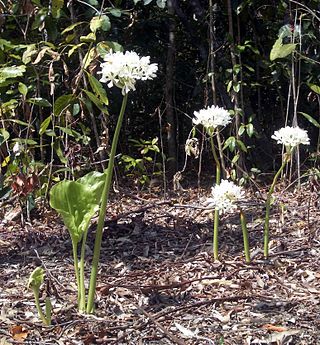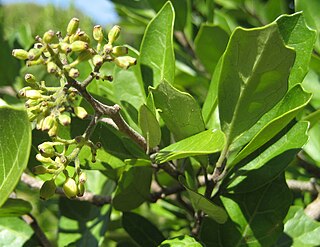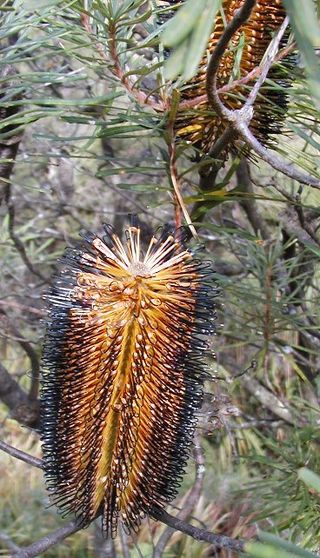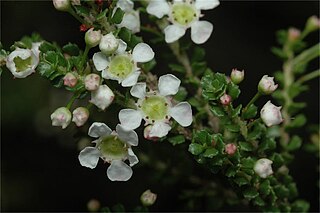Mount Pinbarren is a national park in Queensland, Australia, 129 km north of Brisbane. It is located in Pinbarren, a locality in the Shire of Noosa. Mount Pinbarren lies within the South East Queensland bioregion and the Mary River catchment area.

Allan Cunningham was an English botanist and explorer, primarily known for his travels in Australia to collect plants.

Araucaria cunninghamii is a species of Araucaria known as hoop pine. Other less commonly used names include colonial pine, Queensland pine, Dorrigo pine, Moreton Bay pine and Richmond River pine. The scientific name honours the botanist and explorer Allan Cunningham, who collected the first specimens in the 1820s.

Nothofagus cunninghamii, commonly known as myrtle beech or Tasmanian myrtle, is the dominant species of cool temperate rainforests in Tasmania and Southern Victoria. It has low fire resistance and grows best in partial shade conditions.

Banksia spinulosa, the hairpin banksia, is a species of woody shrub, of the genus Banksia in the family Proteaceae, native to eastern Australia. Widely distributed, it is found as an understorey plant in open dry forest or heathland from Victoria to northern Queensland, generally on sandstone though sometimes also clay soils. It generally grows as a small shrub to 2 metres (7 ft) in height, though can be a straggly tree to 6 metres (20 ft). It has long narrow leaves with inflorescences which can vary considerably in coloration; while the spikes are gold or less commonly yellowish, the emergent styles may be a wide range of colours – from black, purple, red, orange or yellow.

Alsophila cunninghamii, synonym Cyathea cunninghamii, also known as the gully tree fern and slender tree fern, is a species of tree fern indigenous to New Zealand including North Island, South Island and Chatham Islands; also to Victoria, possibly New South Wales, southeastern Queensland and Tasmania in Australia. It grows in damp forest, often emerging from stream gullies and riverbanks. Brownsey noted that it has a lower tolerance for drought than other related species. The erect trunk may be 20 m tall and is usually 6–15 cm in diameter, occasionally as much as 20 cm. Fronds are tri- to tetrapinnate and 3 m or more in length. The rachis and stipe are slender, black brown, warty and covered with brown scales. Sori occur along each side of the pinnule midvein and are covered by hood-like indusia. A. cunninghamii is an uncommon and slow-growing tree fern.

Actinodium cunninghamii, commonly known as swamp daisy or Albany daisy, is the only formally described species in the genus of flowering plants in the family Myrtaceae, Actinodium and is endemic to Western Australia.

Proiphys amboinensis is a species of flowering plant. It was named after the island of Ambiona, now Ambon, in Indonesia. Common names include Cardwell lily and northern Christmas lily. It is considered native to Thailand, Indonesia, the Philippines, the Bismark Archipelago, Vanuatu, New Guinea, Queensland and Western Australia. Is also naturalized in Seychelles, Sri Lanka, Solomon Islands, Niue, Society Islands, Caroline Islands and Mariana Islands.

Banksia spinulosa var. collina is a shrub that grows along the east coast of Australia, in Queensland and New South Wales. Commonly known as Hill Banksia or Golden Candlesticks, it is a taxonomic variety of B. spinulosa. It is a popular garden plant widely sold in nurseries.

Pennantia is the sole genus in the plant family Pennantiaceae. In older classifications, it was placed in the family Icacinaceae. Most authorities have recognised three or four species, depending on whether they recognised Pennantia baylisiana as a separate species from Pennantia endlicheri. British-born botanist David Mabberley has recognised two species.

Banksia spinulosa var. cunninghamii, sometimes given species rank as Banksia cunninghamii, is a shrub that grows along the east coast of Australia, in Victoria and New South Wales. It is a fast-growing non-lignotuberous shrub or small tree infrequently cultivated.

Verticordia cunninghamii, commonly known as tree featherflower or liandu, is a flowering plant in the myrtle family, Myrtaceae and is endemic to an area in the extreme north of Western Australia and the Northern Territory. It is a spindly shrub or small tree with narrow leaves and cream to white, sweetly scented, feathery flowers.

Pennantia cunninghamii, known as brown beech, is a species of flowering plant in the family Pennantiaceae and is endemic to eastern Australia. It is a tree with a fluted trunk, elliptic or oblong leaves and white, either bisexual or male flowers.

Adenanthos × cunninghamii, commonly known as woollybush, Albany woollybush or prostrate woollybush, is a hybrid shrub in the family Proteaceae. It is endemic to the south-west of Western Australia. The Noongar peoples know the plant as boyur.

Crotalaria cunninghamii, also known as green birdflower, birdflower ratulpo, parrot pea or regal birdflower, is a plant of the legume family Fabaceae, named Crotalaria after the Greek word for rattle, because their seeds rattle, and cunninghamii after early 19th century botanist Allan Cunningham. Crotalaria cunninghamii is known as Mangarr to the Nyangumarta Warrarn Indigenous group.

Medicosma cunninghamii, commonly known as pinkheart or bonewood, is a species of shrub or small tree in the family Rutaceae and is endemic to eastern Australia. It has simple, narrow oblong to lance-shaped leaves and small white or cream-coloured flowers arranged in small groups.

Persoonia myrtilloides, commonly known as myrtle geebung, is a plant in the family Proteaceae and is endemic to New South Wales. It is an erect to spreading shrub with elliptic to egg-shaped leaves and yellow flowers in groups of up to forty on a rachis up to 170 mm (6.7 in) long.

Lysiphyllum cunninghamii is a species of plant in the family Fabaceae. It is native to northern Australia where it occurs from Western Australia through the Northern Territory to Queensland.
Grevillea cunninghamii is a species of flowering plant in the family Proteaceae and is endemic to the north of Western Australia. It is a shrub with egg-shaped leaves with sharply-pointed teeth on the edges, and clusters of red flowers.

Sannantha cunninghamii is a species of flowering plant in the myrtle family, Myrtaceae and is endemic to eastern New South Wales. It is a shrub with round to broadly elliptic leaves with irregular edges, and white flowers arranged singly, in pairs or groups of three in leaf axils.


















